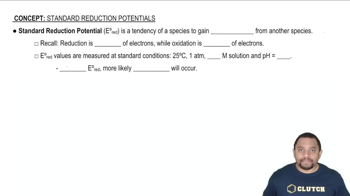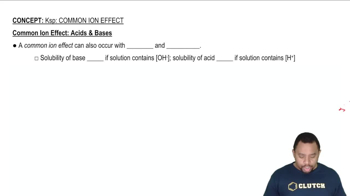Is each of the following substances likely to serve as an oxidant or a reductant: (a) Ce3+(aq) (b) Ca(s) (c) ClO3-(aq) (d) N2O5(g)?
Based on the data in Appendix E, (a) which of the following is the strongest oxidizing agent, and which is the weakest in acidic solution: Br2, H2O2, Zn, Cr2O72-?
 Verified step by step guidance
Verified step by step guidanceKey Concepts
Oxidizing Agents

Standard Reduction Potentials

Acidic Solution Effects

(a) Assuming standard conditions, arrange the following in order of increasing strength as oxidizing agents in acidic solution: Cr2O72-, H2O2, Cu2+, Cl2, O2.
(b) Arrange the following in order of increasing strength as reducing agents in acidic solution: Zn, I-, Sn2+, H2O2, Al.
Given the following reduction half-reactions:
Fe3+(aq) + e- → Fe2+(aq) E°red = +0.77 V
S2O62-(aq) + 4 H+(aq) + 2 e- → 2 H2SO3(aq) E°red = +0.60 V
N2O(g) + 2 H+(aq) + 2 e- → N2(g) + H2O(l) E°red = -1.77 V
VO2+(aq) + 2 H+(aq) + e- → VO2+ + H2O(l) E°red = +1.00 V
(a) Write balanced chemical equations for the oxidation of Fe2+(aq) by S2O62-(aq), by N2O(aq), and by VO2+(aq).
Given the following reduction half-reactions:
Fe3+(aq) + e- → Fe2+(aq) E°red = +0.77 V
S2O62-(aq) + 4 H+(aq) + 2 e- → 2 H2SO3(aq) E°red = +0.60 V
N2O(g) + 2 H+(aq) + 2 e- → N2(g) + H2O(l) E°red = -1.77 V
VO2+(aq) + 2 H+(aq) + e- → VO2+ + H2O(l) E°red = +1.00 V
(b) Calculate ∆G° for each reaction at 298 K.
